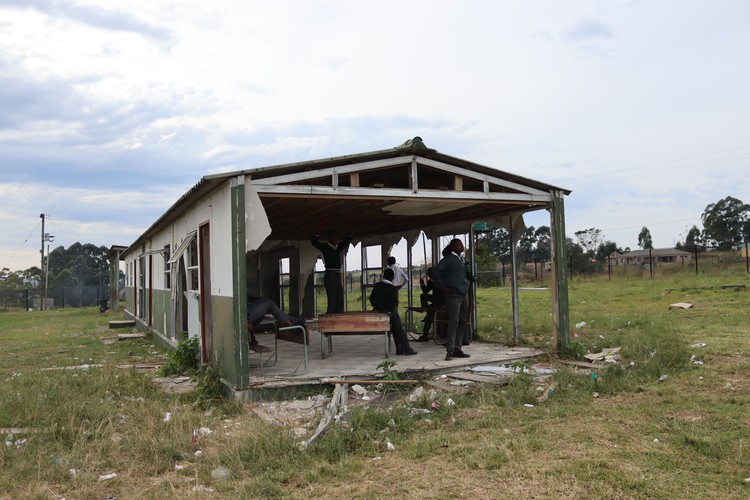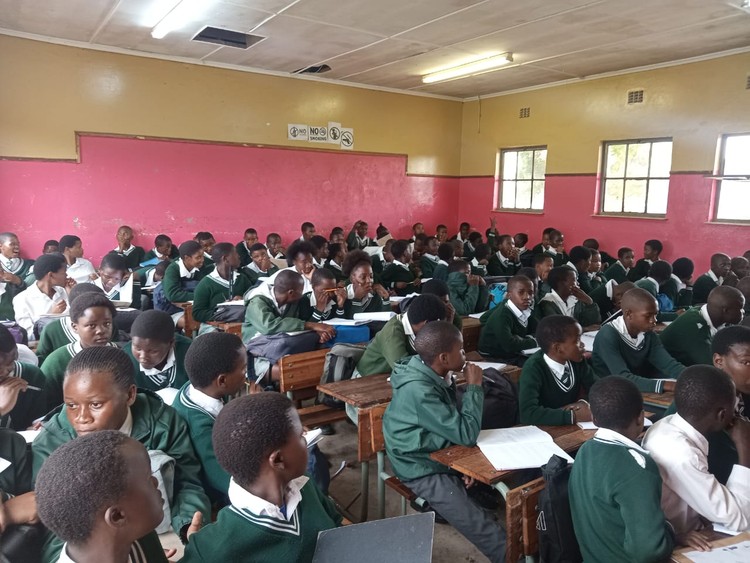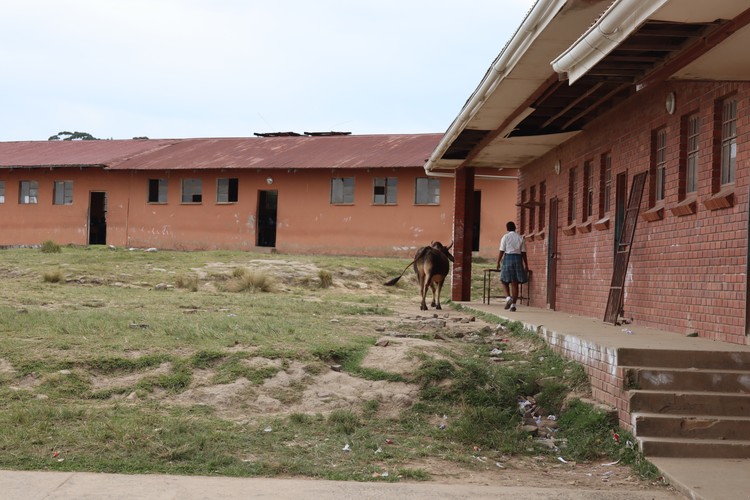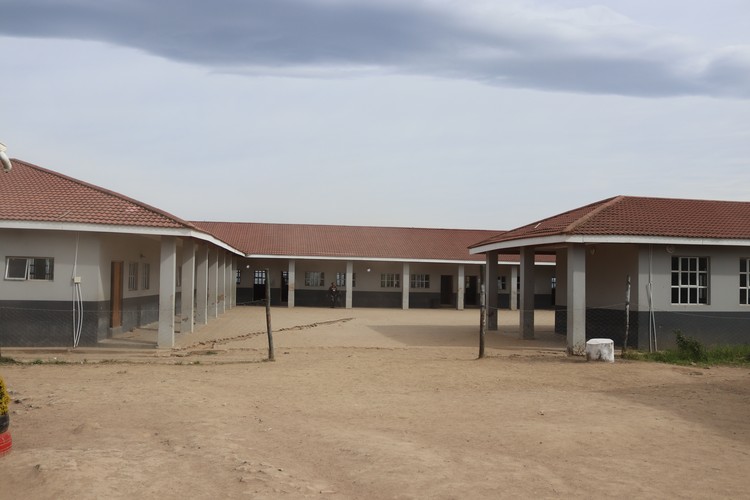In 2013, Zakes Mda was horrified to see 110 learners in a class in this school. Twelve years later, nothing has changed
A third of schools in the Eastern Cape do not meet minimum norms and standards
Prefab classrooms delivered to Putuma Junior Secondary School in 2018 are now in disrepair and no longer in use. Photos: Nombulelo Damba-Hendrik
In 2013, Zakes Mda and Archbishop Thabo Makgoba led a delegation of writers and activists to visit rural Eastern Cape schools. They were shocked to find crumbling, overcrowded classrooms. Twelve years later, little has changed, and the Eastern Cape Department of Education is ignoring our questions.
GroundUp visited the schools in 2022, nine years after the “solidarity visit” by Mda and Makgoba, that was organised by Equal Education. The schools were in a poor condition, with pit toilets and insufficient classrooms. We went back in May this year. The pit toilets which made author Sindiswe Magona cry after the 2013 visit, have been replaced. But learners are still being taught in classes of more than 100 in two of the schools.
However, at the third school, a new building donated by a former learner has made a big difference.
At Putuma Junior Secondary School in Mqanduli, some classrooms have between 70 and 110 learners.
“Unfortunately in this situation we just have to make it work,” says grade 9 learner Siyamthanda Nyangiwe, who shares a classroom with 107 learners.
“At least we are all serious about studying and we try by all means to make things easy for our teachers.”
Sea View Senior Secondary School, close to Putuma, has 111 grade 10 learners in a classroom and its 260 grade 12 learners share three classrooms – more than 80 per classroom. In Grade 8, there are 184 learners split into three classrooms.
But at Ntapane Junior Secondary School, 20km from Mthatha, there has been much improvement since our last visit in 2022, thanks to a new building donated by a former learner.
We visited a fourth school in 2022, Nyangilizwe Senior Secondary School, but we were unable to go back this year because the principal declined our request.
Putuma
Putuma has only eight classrooms for more than 750 learners. When it rains, the roofs leak and teachers send learners home. Although some furniture has been provided by the department of education, there still aren’t enough desks in some classes. Three or four learners have to share one desk.
Amyoli Tumzela, a grade 4 learner, said her classroom is freezing in cold weather and the windows and roof are broken. “You can see the sky while inside, rain comes in, there’s no place to hide,” she said.
“Our government is so silent about this school, they are so quiet you would swear that they don’t know about it. They are not even promising to build us a school. Most people in this village are unemployed. We rely on social grants; there’s nothing much we can do. We need our government to build us a better school or at least add more classrooms,” said School Governing Body chair Leonard Mpetsheni.
“This year, we turned away more than 700 learners who wanted to study here. Those parents are now forced to send their children to schools that are far away,” he said.
Every year, the school receives around R100,000 to spend on infrastructure. But it is not enough.
“Last year we had a disaster, strong winds blew the roof from most of the classrooms. The matter was reported to the department but the roof was never fixed. We used the infrastructure budget because we needed those classrooms,” said SGB treasurer Mulelo Mpiyonke.
Pit latrines have been replaced with new toilets since our last visit.
Putuma Junior Secondary School has between 70 and 100 learners in a classroom.
Sea View
At Sea View, there are eight classrooms for 941 learners. Roofs leak in all the classrooms and staff rooms. The principal’s office is used as a store room.
In one prefab building, used for grade 10s, the floor has big holes. Recently, grade 10 learner Abenathi Ntwakhe fell after stepping in one of them. The week before, a teacher fell. “My fear is that if the classroom is not fixed, someone might be injured,” said Ntwakhe.
“The conditions here are very frustrating. Today is sunny. The classroom is so hot, we struggle to concentrate. And when it’s windy or raining it becomes so cold, it also leaks. Teachers try to give those who are struggling one on one sessions,” she said.
Other classrooms are not in better shape. Four classrooms were built by the school governing body. But some of them have no windows and the ceilings are falling apart. The doors are broken.
“Government must build us a new school. When it’s raining we are forced not to come to school or leave school and that is not fair on us. Next year we are doing grade 12, we can’t afford to stay at home because we can’t be at school due to leaking classrooms,” said grade 11 learner Pamela Thekwini.
Since our last visit in 2022, the school has received new toilets, replacing the pit toilets, and a scholar transport service. And despite the crumbling infrastructure, the school achieved a 74% matric pass rate last year, up from 62% in 2022.
The classrooms at Sea View Secondary School built by the School Governing Body.
Ntapane
Ntapane has 18 classrooms for 971 learners, thanks to the donation of a new building by Sisa Ngebulana, a former learner and local businessman. Once finished, the building will contain more classrooms, a kitchen, a computer room, two halls and a library, which are still under construction.
Seven prefab buildings built by the department since our last visit are already in disrepair and not being used.
In 2022, the school had broken flush toilets and filthy pit latrines. But Ngebulana has built several new flushing toilets.
However, the school still faces a shortage of desks and chairs.
The new building under construction at Ntapane Senior Secondary School, donated by a former learner.
Competing for resources
In May, the national Department of Basic Education reported to Parliament’s portfolio committee on basic education on the condition of the 5,022 public schools in the Eastern Cape, where
- 220 are in very poor, unacceptable condition;
- 870 are in poor condition, in need of significant repairs;
- 2,020 are in a fair condition, meaning they only meet some of the minimum standards;
- 1,764 are in good condition; and
- 148 are in excellent condition.
Eastern Cape schools are competing for resources with 35% of schools throughout the country that do not meet all minimum standards. One in three schools in South Africa needs more classrooms, says Ona Matshaya, Equal Education spokesperson.
About 13,600 schools require more toilets, 6,300 schools don’t have a sustainable water supply, and 8,250 schools need additional classrooms, the department told Parliament.
The department said R129-billion was needed to address the infrastructure backlog, but this money is simply not available. The Education Infrastructure grant is about R14-billion a year.
Questions sent to Eastern Cape Department of Education spokesperson, Vuyiseka Mboxela were not answered despite several follow-up attempts.
Support independent journalism
Donate using Payfast

Don't miss out on the latest news
We respect your privacy, and promise we won't spam you.
© 2025 GroundUp. This article is licensed under a Creative Commons Attribution-NoDerivatives 4.0 International License.
You may republish this article, so long as you credit the authors and GroundUp, and do not change the text. Please include a link back to the original article.
We put an invisible pixel in the article so that we can count traffic to republishers. All analytics tools are solely on our servers. We do not give our logs to any third party. Logs are deleted after two weeks. We do not use any IP address identifying information except to count regional traffic. We are solely interested in counting hits, not tracking users. If you republish, please do not delete the invisible pixel.




